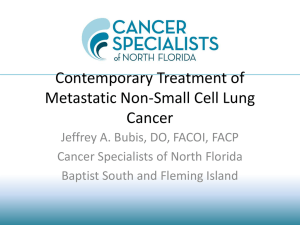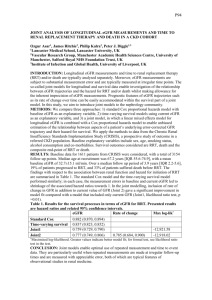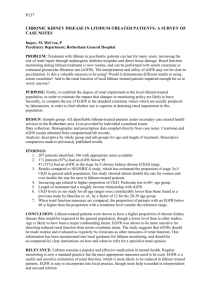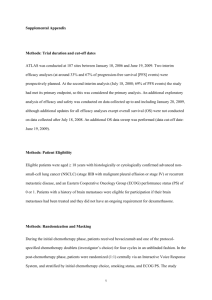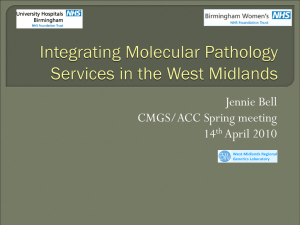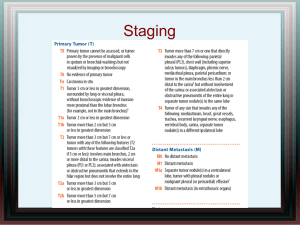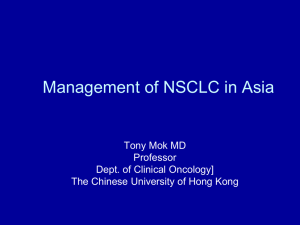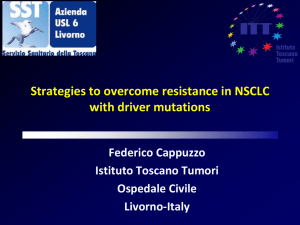(EGFR) – mutation testing - National Health Committee
advertisement
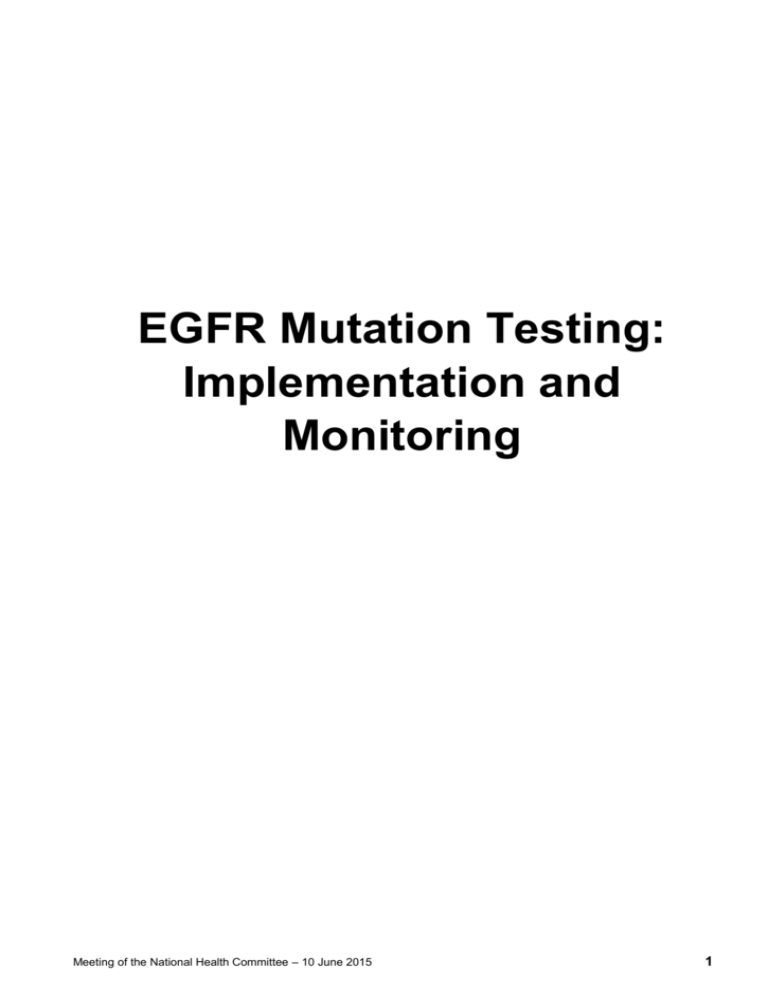
EGFR Mutation Testing: Implementation and Monitoring Meeting of the National Health Committee – 10 June 2015 1 Meeting of the National Health Committee – 10 June 2015 2 In confidence Committee report number 2015121 Epidermal growth factor receptor (EGFR) – mutation testing: implementation and monitoring (Tier 3) Paper for meeting on: 10 June 2015 NHC reference August 2011 2011110 Project plan/initiation document 'National Health Committee Initial Project: EGFR Testing'. May 2012 2012028 NHC's 'Rapid Review on EGFR gene mutation testing in patients with advanced NSCLC for access to gefitinib'. Publication online in June 2012. May 2013 2013019 'EGFR testing in New Zealand: final recommendations' and 'Collated feedback on EGFR draft recommendations'. 'EGFR testing in New Zealand: implementation recommendations'. February 2015 2015028 'EGFR mutation testing – final HRC report'. Executive summary 1. This paper provides a review of the overall epidermal growth factor receptor (EGFR) assessment and introduction of EGFR testing following the presentation of the National Health Committee (NHC) and Health Research Council (HRC) Health Innovation Partnership (HIP) funded report on EGFR mutation testing. This review completes the NHC’s work in the area of EGFR. 2. This review shows that the National Health Committee’s assessment of EGFR prevalence uptake and cost was slightly over-estimated in the 2013 committee papers (2013019), but the recommendations arising from that assessment were sound. It should be noted that the prevalence of EGFR mutation in the studied population is more likely an over representation than an under representation of the actual number in the whole of New Zealand population. Prevalence of EGFR mutation was higher in Asian, Pacific and female patients, these patients are over represented in the studied population compared to the New Zealand NSCLC patient population. 3. The cost-effectiveness of EGFR testing is based on the overall testing process, including the type of specimen required for testing and specimen collection, transport, preparation for testing and the complexity of the test. 4. It will be necessary to update the NHC’s EGFR recommendations to reflect the data we now have on the prevalence of the EGFR gene mutation in the New Zealand population. 5. The NHC’s assessment of EGFR has provided a number of learnings that will be valuable in the committee’s ongoing strategic work in the areas of cross-sector collaboration, innovation, investment, managing diffusion, and maximising value from new technologies and the strategic omics work programme. It is recommended that the committee: a) Note the information provided in the EGFR implementation and monitoring assessment paper. Yes / No b) Note the supplement to the recommendation update (Appendix 1). Yes / No c) Agree that the NHC's EGFR mutation testing recommendations to district health boards be updated by including the results of the EGFR mutation testing – final Health Innovation Partnership (HIP) report. Yes / No Agree that the updated NHC recommendations will be communicated to stakeholders (Communication Plan) and published online following draft recommendations to the Minister of Health (Committee Report). Yes / No d) Appendix 1: Epidermal Growth Factor Receptor mutation testing: Supplement to Recommendation Update Appendix 2: Draft Committee Report to the Minister of Health Appendix 3: Draft Communications Plan Peer review General Manager Operations Manager/ Implementation Manager NHC Executive contacts: Peter Guthrie General Manager Phone 09 580 9073 Cellphone 021 689 946 Meeting of the National Health Committee – 10 June 2015 Faye Ryan, Implementation Manager Marty de Boer, Acting Operations Manager 4 Purpose 6. This paper provides a high level overview of the completion of the NHC’s work on EGFR assessment and research. 7. This document reviews the actual uptake and utilisation of EGFR testing in light of the results of the NHC/HRC HIP funded research into the prevalence of EGFR mutation in the New Zealand population, and assesses where possible the uptake of the NHC EGFR recommendations to the sector made in 2013. 8. Discussion on the role of EGFR and similar co-dependent technologies in advanced stage disease is also canvassed. Background/Context 9. The NHC has completed a reactive referral assessment on epidermal growth factor receptor (EGFR) mutation testing in non-small cell lung cancer (NSCLC) and targeted treatment with EGFR tyrosine kinase inhibitors (TKIs) as an example of a co-dependent technology. 10. The effectiveness of EGFR TKIs depends on a reliable testing platform along with a consistent, high quality sampling process to identify patients who are likely to respond to treatment; therefore optimal clinical outcomes are dependent on the EGFR mutation rate in the target population, the quality of the sample, the sensitivity and specificity of the assay and the clinical effectiveness of the drug. 11. The EGFR mutation analysis project started in 2011, with PHARMAC approving the co-dependent treatment gefitinib as first line treatment in patients with proven EGFR mutations in 2012. As a consequence, the NHC decided to use the EGFR mutation assessment as a learning project, particularly around sector implementation. 12. A summary of the EGFR assessment process (including the project plan, a briefing paper, Rapid Review, Working Group recommendations, EGFR Heath Innovation Partnership (HIP) research project and implementation recommendations) and an evaluation of the implementation of the recommendations are provided. Discussion 13. The prevalence of EGFR mutations was slightly higher in the New Zealand NSCLC population compared to published Caucasian based cohorts, which was expected given the higher mutation rates in South-East Asian patients and the ethnic linkages between the Pacific and Asia. However it should be noted that the prevalence study population has over an representation of these patient groups compared to the overall New Zealand NSCLC patient population. 14. The EGFR mutation testing assessment shows that the assay used in the research was likely to be sufficient for clinical utility. It should be noted that clinical utility is also dependent on the quality of the specimen submitted for testing. 15. Current assessment shows that the number of lung cancer patients undergoing EGFR testing and receiving gefitinib is lower than forecasted in 2013. 16. Cost-effectiveness of co-dependent technologies is dependent on the overall testing algorithm, which was not assessed at the time of the proposed recommendations. The Meeting of the National Health Committee – 10 June 2015 5 quality of biopsies was not assessed as a crucial factor in cost estimates for the 2013 paper 'EGFR Testing in New Zealand: Implementation Recommendations' (2013019). Feedback from one of the laboratories was that biopsy quality did improve over time after feedback. This learning curve follows evidence observed in overseas research projects. 17. EGFR testing is an example of a co-dependent technology (test and targeted drug) for the treatment of an advanced disease state that prolongs the life of the patient but does not provide a cure. Currently drug-test co-dependent technologies tend to be focused at this point in the model of care with the introduction of similar tests for smaller and smaller patient groups, at the advanced disease stage. 18. A great deal of work has been done around lung cancer screening in New Zealand. It remains to be seen whether these screening technologies are cost effective. Through its work in genomics, innovation and sector relationships, the NHC will continue to highlight the critical importance of early disease innovation. 19. The discovery, development and marketing of accurate, non-invasive, inexpensive lung cancer biomarkers is likely to have significant positive impacts on the early identification, clinical evaluation and management and health outcomes for patients with lung cancer. Lung cancer biomarkers have the potential to lead to advances in primary prevention, chemoprevention, lung cancer screening, lung nodule management, lung cancer diagnosis, and the personalisation of therapeutic choices. 20. Various learnings can be taken from the EGFR assessment and implementation, especially around cross-agency collaboration, data availability, technology development, the needs around laboratory services and investment priorities. Next steps 21. A Committee Report will be provided to the Minister of Health to inform him of the publication of updated recommendations to the sector around EGFR mutation testing in NSCLC patients (Appendix 1). 22. It is proposed to update the NHC’s EGFR mutation testing recommendations presented in the 'EGFR Testing in New Zealand: Implementation Recommendations' paper (2013019) by including the prevalence results. 23. Learnings from the NHC’s EGFR work include: the need for: cross-agency shared work plans (aligning work with PHARMAC); relevant, high quality data to be available in real time to aid sound clinical and business decision making; understanding of the implications of rapid technology development (ie omics-based technologies) and the critical need for NHC and sector agility in this space. The need for a nationally consistent strategic approach around the roles and responsibilities of laboratory services for the delivery of personalised health care services for New Zealanders and the need for new business strategies to increase the investment of available public funds in the prevention, screening, early identification and management phases of a model of care. These learnings will be pulled through into the NHC’s strategic omics work programme. Meeting of the National Health Committee – 10 June 2015 6 Executive summary This document completes the Epidermal Growth Factor Receptor (EGFR) assessment work undertaken by the National Health Committee (NHC) since 2012, and evaluates the uptake by the sector of the implementation approach and recommendations, presented to the Committee in 2013(1). The EGFR assessment process was completed prior to the NHC implementing Treasury’s business methodologies for developing tiered business cases for change across a health model of care. Lung cancer is the fourth most common cancer in New Zealand, and a major cause of death, especially amongst Māori and Pacific people. New Zealand survival rates are poorer than in many Western countries. In 2011, the NHC saw the potential to learn about the use of co-dependent technologies and personalised medicine. The NHC took the opportunity to investigate the use of targeted therapy (tyrosine kinase inhibitors, TKIs), for selected patients whose lung cancers would respond to this class of medication due to their mutations in the EGFR gene. The EGFR mutation test and EGFR TKIs are co-dependent technologies. The drug relies on a reliable testing platform to identify patients who are likely to respond to treatment, and therefore optimal clinical outcomes are dependent on both the assay and the drug. Various co-dependent products are on the market for the treatment of non-small cell lung cancer (NSCLC), including Anaplastic Lymphoma Kinase (ALK) and crizotinib treatment. The EGFR TKI erlotinib has been funded in New Zealand as second-line, non-EGFR targeted treatment since 2010, initially for all patients who previously had chemotherapy. In August 2012, PHARMAC approved gefitinib (another EGFR targeted TKI) as first-line treatment, in patients with proven EGFR mutations. PHARMAC restricted access to first-line EGFR TKI treatment to patients with non-squamous histologies and proven EGFR mutations. The NHC identified that PHARMAC’s requirement for confirmation of gene mutation status, as a prerequisite for treatment, provided an ideal opportunity to use the EGFR mutation assessment as a learning project, especially around technology implementation issues. A Health Innovation Partnership (HIP) research project assessed the accuracy and suitability of existing New Zealand based assay processes and the prevalence of EGFR mutations in the New Zealand patient population in 2013. The results of this research were presented to the Committee at the 4 February 2015 meeting – report # 2015028. The HIP research project has shown that the mutation rate in the New Zealand population was slightly higher compared to Caucasian based study cohorts. This was expected as EGFR mutation rates are higher in South-East Asian patients, and the ethnic linkages between the Pacific and Asia. It should be noted that the prevalence of EGFR mutation in the studied population is more likely an over representation than an under representation of the actual number in the whole of New Zealand population. The cost-effectiveness of tests is dependent on a number of factors including: the specificity and sensitivity of the test, the mutation rate in the population, and the type of specimen required for testing and the model of care for specimen collection, transport, preparation for testing, and the complexity of the test. Meeting of the National Health Committee – 10 June 2015 7 EGFR mutation testing is used in lung cancer patients to establish the available treatment options. The management of end stage lung cancer is a complex, busy space with the available interventions focused on reducing symptoms and delaying death. Currently the investment of effort, time and financial resources, in this part of the lung cancer model of care, is significant. EGFR mutation testing and the co-dependent treatment are being used at the end stage of the model of care for lung cancer patients. Various other co-dependent technologies also sit within this space (ie ALK and BRAF mutations in NSCLC patients and co-dependent treatment), and questions are being raised about the utility of continuing to invest heavily in the development and real world application of an increasing number of new co-dependent technologies that facilitate greater precision in the treatment of small populations with late stage incurable disease. To tackle poor lung cancer survival rates, New Zealand lung cancer patients will need to be diagnosed quickly and rapid treatment uptake is crucial. It becomes apparent that more consideration needs to be given to developing technologies for the prevention, early identification and early management of patients with lung cancer. Meeting of the National Health Committee – 10 June 2015 8 Contents Executive Summary ............................................................................................................ 7 1 Purpose ....................................................................................................................... 10 2 Background ................................................................................................................ 10 3 EGFR mutation testing assessment ......................................................................... 12 3.1 The Project Plan/Initiation document...................................................................... 12 3.2 Rapid review ...................................................................................... 12 3.3 The Working Group recommendations .................................................................. 13 3.4 NHC recommendations for EGFR testing in New Zealand ..................................... 13 4 EGFR research report ................................................................................................ 15 5 Introduction of EGFR mutation testing ..................................................................... 16 5.1 Feedback from laboratories ................................................................................... 18 6 Discussion .................................................................................................................. 19 References ......................................................................................................................... 22 Meeting of the National Health Committee – 10 June 2015 9 1 Purpose The purpose of this document is to complete the Epidermal Growth Factor Receptor (EGFR) mutation testing assessment and to assess the current use of this technology in the treatment of lung cancer in New Zealand. To complete the assessment, a quick overview will be given of the work done in the last three years. The cost effectiveness of co-dependent technologies is sensitive to a number of factors including; the sensitivity and specificity of the test, the mutation rate in the (New Zealand) population, the type of specimen required for testing and the mode of specimen collection, transport, and preparation for testing. The EGFR Health Innovation Partnership (HIP) research project answered questions around the mutation rate in the New Zealand population. 2 Background Lung cancer is the fourth most common cancer in New Zealand (2), and a major cause of death, especially amongst Māori and Pacific people. The five-year relative survival rate of lung cancer patients in New Zealand is lower compared to various other OECD countries. Lung cancer data from 1997 to 2002, published in 2013 by the OECD, shows that average age-standardised survival rate in OECD countries was 12.7%, ranging from 7.4 to 25.6%. New Zealand’s 5 year survival rate was 10.6 %, compared to 12.8% for Australia and 15.8% for Canada (3). Poor survival rates of New Zealand lung cancer patients could relate to many different things, including lower initial treatment rates and/or lower initial early identification rates (4). Lung cancer is categorised by histology (the microscopic structure of tissue), and is broadly divided into small cell lung cancer (SCLC) and non-small cell lung cancer (NSCLC). NSCLC represents 8090% of cases. NSCLC is further divided based on the tissue of origin (histological classification or “histology” of the cancer). The most common subtypes are adenocarcinoma (50-60%) and squamous cell carcinoma (30-40%), but there are a number of other less frequent subtypes (~10%). Various genomic and epigenetic abnormalities have been reported in lung cancer patients. One of the advances in lung cancer treatment has been the development of EGFR-targeted tyrosine kinase inhibiting medications (TKIs). Subsequently EGFR mutations were discovered in patient’s tumour cells, which influence the responses to specific TKIs. Patients who have EGFR mutations respond to TKIs which have been shown to improve progression free survival and reduce morbidity. EGFR TKIs are not a cure but modest response rates and overall survival benefit have been observed in a subset of patients with advanced NSCLC (11). Globally, it is expected that the NSCLC drug market will increase from USD 4.3 billion in 2009 to USD 6.9 billion in 2019. Erlotinib (Tarceva) is in the top 10 pharmaceutical spends globally with sales of $564.2 million in 2011(12). EGFR mutation testing and EGFR TKIs are an example of co-dependent technologies. The drug relies on a reliable testing platform to identify patients who are likely to respond to treatment, and therefore optimal clinical outcomes are dependent on both the assay and the treatment. A reliable testing platform is dependent on the quality of test sample and the sensitivity and specificity of the assay. Meeting of the National Health Committee – 10 June 2015 10 The cost effectiveness of this co-dependent technology in the model of care for NSCLC is dependent on: The specific, measurable health and independence outcomes achieved through the application of the co-dependent technology The quality and costs of specimen collection and management The sensitivity, specificity and costs of the EGFR testing platform that is used The EGFR mutation rate in the population in question, and The nature and cost of the learning curves for specimen collection, management and application of the EGFR testing platform. The use of co-dependent technologies in cancer diagnosis and treatment has grown significantly over the past decade, with EGFR mutation testing at the forefront of the growing clinical use of omicsbased testing in personalised health care. Most of these co-dependent technologies, used in lung cancer, focus on end stage cancer treatment. In 2011, the NHC commenced an assessment of targeted therapy for selected patients whose lung cancer harbour mutations in the EGFR gene. Internationally EGFR mutations are found in approximately 10 – 12% of non-Asian patients with advanced NSCLC and 30 – 40% of Asian patients (5). However, the prevalence of EGFR mutations in the New Zealand lung cancer population was unknown at the time of publication of the NHCs 2013 recommendations, and variations were expected between Maori, Pacific and other ethnic groups. The EGFR TKI erlotinib has been funded by PHARMAC since 2010 as second-line treatment for all patients who had previously received standard chemotherapy. In August 2012, PHARMAC approved gefitinib (a different TKI) as first-line treatment, in patients with NSCLC and proven EGFR mutations. EGFR TKIs are not a cure, but modest response rates were observed in 58 – 83% of the patients. Median survival rates of ~ 23.3 months were observed in advanced stage NSCLC patients with EGFR mutations. Traditional chemotherapy for this group of patients has a 20 - 30% response rate and extends median survival from ~5 months to ~12 months. As PHARMAC restricted access to first-line EGFR TKI treatment to patients with non-squamous histologies and proven EGFR mutations, the NHC decided to use the EGFR mutation assessment as an opportunity to learn about the introduction and diffusion of this type of co-dependent technology. 3 EGFR mutation testing assessment Personalised Medicine is a complex and difficult research space; many oncogenes are informative scientifically but are not medically useful. Some clinicians and researchers question the short-term benefits of routine, large-scale tumour sequencing in patients (6). The treatment for lung cancer creates significant economic burden with high treatment cost for end stage disease (ie EGFR TKIs). At the time of PHARMAC’s approval of gefitinib the NHCs assessment was not yet finalised, but the NHC and PHARMAC agreed that the assessment process would post date the approval of the drug. The development of the NHC’s EGFR recommendations was completed in a number of stages from February 2012. The sequential development of the EGFR assessments is detailed below. It should be noted that the work pre-dates the use of the NHC’s tiered business cases for change methodology. Meeting of the National Health Committee – 10 June 2015 11 3.1 The Project Plan/Initiation document When the EGFR project plan was presented to the Committee in August 2011, the main objectives for the project were: To assess the feasibility of funding EGFR testing in a way that is accepted by the sector, is robustly funded, and has a realistic implementation plan. To assess the funding of EGFR tests against the then five domains of the NHC decision criteria (clinical, financial, economic, social, and ethical). To inform the future development of the NHC’s role in the sector’s decision making on diagnostic laboratory technologies, including genetic testing and complementary technologies, and to learn how to work with the relevant stakeholders. The project plan noted that: “The project is unlikely to solve the strategic issues directly. The project plan therefore suggests that a strategic goal for this EGFR project could be for the NHC to learn about the strategic issues and to guide future choice of projects and activities.” 3.2 Rapid Review As PHARMAC was planning to go to consultation with a proposal to fund the TKI gefitinib for first line treatment, the Executive prepared a Rapid Review of the evidence available. This Rapid Review, presented to the Committee in May 2012, and a summary version published online in June 2012, was written in the context of PHARMAC’s proposal. Based on data from the Australian Medical Services Advisory Committee (MSAC), it was estimated that approximately 1,214 patients in New Zealand would be eligible for EGFR mutation testing (NSCLC, non-squamous or NOS). Cancer stage was not taken into account for these estimates. Progression-free survival (PFS) results were presented, comparing response to gefitinib with response to chemotherapy as first-line treatment. In the case of EGFR positive mutations, PFS was 9.6 months for gefitinib compared to 6.3 months for chemotherapy. In mutation negative patients, PFS was 1.6 months compared to 5.5 months (7). Presentation of the Rapid Review resulted in the recommendation that EGFR mutation testing should be publicly funded and that further investigation was needed around the implementation of EGFR mutation testing in New Zealand through engagement with the sector. This resulted in the commissioning of a working group. 3.3 The Working Group recommendations The Working Group developed recommendations for a pragmatic approach to the implementation of sample acquisition and testing for EGFR mutations in New Zealand. The group advised that EGFR testing should be undertaken in New Zealand rather than Australia, which reflected the need to combine a cost-effective testing program, timely turnaround for results, and development of genetic testing capability for the future. Turnaround time was noted as an initial ‘Key Performance Indicator’ of testing and should be reviewed within 12-18 months after the initiation of co-ordinated testing. The recommended turnaround time for the mutation test should be five working days from the arrival of the sample in the molecular diagnostics laboratory. Adequate sample preparation (e.g. ready for analysis, clearly Meeting of the National Health Committee – 10 June 2015 12 marked and with sufficient tumour content) by the referring laboratory is imperative in achieving this turnaround time. 3.4 NHC recommendations for EGFR testing in New Zealand On the basis of the clinical recommendations from the Working Group the NHC liaised with DHBs, the Ministry of Health and the National Health Board (NHB) to develop an approach to the implementation and funding of the recommendations. These recommendations were presented in the paper “EGFR Testing in New Zealand: Implementation Recommendations” in May 2013. The recommendations were not intended as a definitive business case, but instead as a suggested path forward, tailored to New Zealand’s workforce and expertise, geographic distribution, funding structures and with a view to its future capability and capacity for genetic and genomic testing. The 2013 paper proposed that EGFR mutation testing would offer an opportunity to build the expertise, infrastructure and approach to this rapidly expanding area of personalised medicine in New Zealand. The proposed testing algorithm is presented in Figure 1. Meeting of the National Health Committee – 10 June 2015 13 Figure 1: Testing algorithm prior to EGFR mutation testing and NHCs proposed testing algorithm (May 2013). Source: NHC Estimates were given of approximately 1,020 – 1,175 tests performed per year (based on 85-98% uptake of testing in NSCLC with non-squamous histology). At a cost of $300 - $500 per test (in line with Australian experience), the cost for the whole sector was estimated to amount to $357,000 $587,500 per year. Estimates around the net avoided costs, based on assessment by the NHC, was approximately $300,000 per annum over at least three years. The net avoided cost was based on the difference in costs of uncontrolled expansion to four laboratories compared to controlled diffusion by restricting testing to two laboratories. Meeting of the National Health Committee – 10 June 2015 14 The NHC's recommendations resulted in the development and distribution of the paper: “Epidermal Growth Factor Receptor mutation testing for access to gefitinib in first-line treatment for advanced Non-Small Cell Lung cancer” in June 2013(1). This paper was distributed to the sector, but was not published online. The NHC's recommendations proposed that more than one laboratory should provide EGFR mutation testing in New Zealand (based on lung cancer registrations in 2009). EGFR mutation testing, using the Cobas real-time PCR platform, was being provided in New Zealand by two public (Auckland DHB and Canterbury DHB) and one private laboratory (PathLab, Bay of Plenty). All three laboratories were currently IANZ accredited. Increased reagent costs of $47,000/year were estimated if four laboratories were funded compared to two, due to reduced batching of samples. This assumption could not be confirmed at the time due to a lack of data. In order to establish the clinical utility of an EGFR testing platform and the co-dependent TKI treatment for New Zealand patients with NSCLC it was necessary to first determine the prevalence of EGFR mutations in the New Zealand population with NSCLC. Health Innovation Partnership (HIP) funding was made available for an EGFR research project to answer this evidence gap. 4 HIP EGFR research report The main objectives of the research were to: (i) determine prevalence of EGFR mutations in New Zealand NSCLC patients; and (ii) define the local mutation prevalence by ethnicity A secondary objective was to examine the actual performance of the currently used FDA approved Cobas EGFR mutation tests in the New Zealand population. It should be noted that the Cobas EGFR mutation test was compared to a non-FDA approved assay. As the specificity of the comparative assay is unknown it is difficult to assess the overall specificity of the Cobas assay. One of the NHC’s recommendations was that EGFR mutation testing should be reviewed if prevalence of EGFR mutations was either significantly higher or lower than international comparisons. The final HIP research report found that that: (i) EGFR mutation-positive lung cancer is slightly more prevalent among New Zealand lung cancer patients compared to some international reports (Caucasian study cohorts), which was expected as prevalence is higher in East-Asian patients and the potential genetic linkages between East-Asian and Pacific populations; (ii) EGFR mutations were more prevalent in South-East Asian and Pacific patients and less common in NZ European and NZ Maori patients, and; (iii) the Cobas EGFR Mutation test was an accurate diagnostic assay for detecting EGFR gene mutations in clinical samples from New Zealand lung cancer patients (positive percentage agreement > 90%). EGFR mutation test reports, using the Cobas EGFR mutation test, were available for 826 patients in the study population. EGFR mutations were detected in 145 of these patients (17.6%), no EGFR mutation was detected in 584 patients (70.7%) and invalid results were reported for 27 patients (3.3%). Invalid results were identified by the machine, this could be caused by unexpected negative or positive control results, invalid set up of the machine itself or low level of DNA. The remaining 70 had either: no patient record, no report, no result or the wrong test was performed. Taking out these 70 samples, the New Zealand prevalence of EGFR mutations was 19.9% (145 out of 729 patients). Meeting of the National Health Committee – 10 June 2015 15 As expected, EGFR mutations were more prevalent in South East Asian and Pacific patients (39.6% and 24.4% respectively) and less common in NZ European patients (17.6%). Interestingly, EGFR mutations were also less common in NZ Maori patients (10.2%), however this did not reach statistical significance (p=0.09). Lower mutations rates in NZ Maori patients did not seem to be confounded by high incidence of smoking in the Maori population, based on this relatively small study group (414 patients, 59 NZ Maori). It should be noted that the prevalence of EGFR mutation in the studied population is more likely an over representation than an under representation of the actual number in the whole of New Zealand population. Prevalence of EGFR mutation was higher in Asian, Pacific and female patients, these patients are over represented in the studied population compared to the New Zealand NSCLC patient population. Concerns were raised about the overall quality of biopsies. International research has shown that up to 33% of the samples were of insufficient quality to be assessed, but a rapid learning curve resulted in improvement of sample quality within the first year (8, 9). This was also noted by one of the laboratories offering EGFR mutation testing in New Zealand where improvement was observed after feedback was given by the laboratory to the referring clinician. The rapid learning curve in New Zealand echoes that seen in other jurisdictions on the introduction of EGFR testing(8, 9). Analysis of mortality outcomes, which was planned to be part of the EGFR HIP research project, is planned for late 2015. Results are expected to be available within three to four months and will be presented as an addendum to the report1. 5 Introduction of EGFR mutation testing The implementation of EGFR mutation testing in NSCLC patients in New Zealand was not driven by the NHC. The NHC involved the relevant sector leaders, as part of the Working Group, and agreed on the key elements for successful, sustained implementation. One of the NHC's recommendations was that EGFR mutation data would need to be registered and audited. This would support future testing by recording prevalence and patient outcomes. The recording of EGFR mutations in the New Zealand Cancer Registry commenced at the beginning of 20152. Auditing of Table 2: Count of new these registrations will commence in 2017. registrations of non-small cell Various recommendations were made by the Working Group around the quality of the test and the samples. As part of the EGFR research project, the EGFR mutation test was shown to be sufficient for clinical utility, but samples also need to be of sufficient quality to guarantee valid EGFR mutation results. The HIP research project has shown that the cost-effectiveness of codependent technologies depends heavily on specimen collection and management. For example, quality of samples depends on biopsy size and percentage of tumour cells in the sample. The size of the NSCLC (non-squamous) population, using Cancer Registry data, shows an average of 903 annual registrations for 1 Luke Garland, Health Research Council, Personal communication, April 2014. 2 New Zealand Cancer Registry, Personal communication, April 2014. Meeting of the National Health Committee – 10 June 2015 lung cancer (non-squamous) per year Year Count 2009 890 2010 863 2011 900 2012 945 2013 919 Average per year 903 Source: 2015 NHC analysis of 2009 to 2013 NZ Cancer Registry 16 2009-2013 (Table 2). Frequency of ‘new patients’ on gefitinib, based on data available, was 43 in 2012 and 96 in 20133. Data analysis has shown that of these 139 patients on gefitinib, 122 were linked to the Cancer Registry for their lung cancer. Incomplete linkages may be because these patients have a different primary malignant disease. Assessment of registered patients showed that access to testing and therefore to gefitinib was spread equitable across the country, ‘new patients’ on gefitinib were registered in 20 DHBs. Reimbursement data available showed that the average cost of gefitinib prescriptions was $2,054 with a total of 470 reimbursements in the year 2012/2013 and 426 reimbursements in the year 2013/2014. This resulted in overall reimbursement cost of $963,028 for the year 2012/2013 and $822,743 for the year 2013/2014 (NHC analysis of reimbursement cost, Vote: Health cost data). Gefitinib is a 200 mg tablet, given daily, and treatment response is assessed. Gefitinib costs approximately $56 NZD per tablet, resulting in overall cost of approximately 20,440 NZD per year. Assessment of the available data shows that the number of patients eligible for EGFR mutation testing (NSCLC, non-squamous) is lower than estimated in 2013 (903 patients vs 1,020 – 1,175 patients). Based on the predicted numbers, annual cost is likely to be $383,773 - $442,470 (based on 85-98% uptake of testing and $500 assay cost). As prevalence of EGFR mutation was 20% in the New Zealand population this would mean that per annum 154 – 177 patients are likely to be eligible for gefitinib treatment. Based on a 70% uptake in eligible patients in the EGFR study, 107 – 124 patients were likely to receive gefitinib per year. These estimates suggest that gefitinib uptake is likely to increase (from 43 and 96 in 2012 and 2013 respectively), but as data in the Cancer Registry is only available up to 2013, this is cannot be confirmed. 5.1 Feedback from laboratories Feedback on the implementation of EGFR testing was requested from all three laboratories. PathLab was the only laboratory submitting feedback for this report. PathLab noted a ‘gentle steady increase’ of EGFR testing from the Waikato, Bay of Plenty, Hawkes Bay and Taranaki and are currently running around the 200 tests per year. Most patients with a diagnosis of non-small cell carcinoma (NSCLC) of the lung have been offered the test, however actual patient and testing numbers were not provided. It was noted that in some cases clinicians chose not to test/biopsy the frail and elderly, this was suggested as being up to 25% of the patients. This will result in a reduction in the estimated number of tests performed above. According to PathLab, of the patients being tested, less than 10% of the tests were invalid and these numbers have fallen dramatically after feedback to the biopsying clinicians. PathLab also has standardised request form formats and all specimens are reviewed by a pathologist before testing. Turnaround time for the EGFR mutation testing is usually 72 hours, which is less than the recommended 5 working days. PathLab has so far not recorded mutations in the New Zealand Cancer Registry. As information was only available from PathLab, total numbers of tests performed and clinical utility of the assay in the New Zealand context cannot be further assessed. 3 2015 NHC analysis of 2009 to 2013 NZ Cancer Registry Meeting of the National Health Committee – 10 June 2015 17 6 Discussion The EGFR assessment process has now been completed with the receipt of the HIP EGFR mutation testing – final report. The Working Group and the HIP report identified a number of key considerations which will need to be addressed, around the implementation of co-dependent technologies and the introduction of personalised medicine. A review of the overall EGFR assessment and introduction of EGFR testing has been presented in this document. EGFR mutation testing and EGFR TKIs are an example of co-dependent technologies, which means that correct targeting of the drug depends on a genomic/genetic test or diagnostic. The cost effectiveness of these tests is dependent on a number of factors including: Specificity and sensitivity of the test The mutation rate in the local population The type of specimen required for testing and the mode of specimen collection, transport, preparation for testing, and the complexity of the test. The HIP EGFR research project has determined the prevalence of EGFR mutations in the New Zealand population of patients with NSCLC. The research project also confirmed that the Cobas realtime PCR EGFR mutation testing platform performs within published specifications when applied to the New Zealand population of patients with NSCLC. It should be noted that the Cobas EGFR mutation test was compared to a non-FDA approved assay which makes it more difficult to assess the specificity of the performed analyses. A non-FDA approved assay has not proven to have the specificity needed for clinical use so it makes it unclear how specific the tested assay as well as the comparative assay is. The manufacturer used a different comparative assay to prove specificity which makes it impossible to compare the positive and negative agreement percentages with the ones observed in the manufacturers assays. Three laboratories (two public and one private) are currently offering EGFR mutation testing, using the Cobas platform. The EGFR mutation analysis project aimed to link first line treatment of EGFR mutation positive patients with gefitinib to enhanced survival rates in the New Zealand NSCLC population. Whether treatment with gefitinib results in better patient outcomes for this group is, as yet, unclear. Results around ‘survival’, from the research group, are expected within the next three to four months. Prospective data available from the NZ Cancer Registry will only be available in two years’ time. Various lessons were learned from the HIP report around the mode of specimen collection and management. Clinicians and pathologists became better informed about the required quality of sampling and specimen management prior to EGFR testing. The overall sampling quality has improved over the time of the learning curve. EGFR TKIs are used in patients with advanced stage lung cancer. The management of end stage lung cancer is a complex, busy space with various new technologies being developed and multiple treatment options being available. The investment of effort, time and financial resources by researchers, pharmaceutical companies, diagnostic companies, patients, insurers and health payers is significant with limited resultant improvement in health outcomes. EGFR TKIs are not a cure but modest response rates and overall survival benefit have been observed in a subset of patients with advanced NSCLC (11). Meeting of the National Health Committee – 10 June 2015 18 Lung cancer is the fourth most common cancer in New Zealand (2), and a major cause of death, especially amongst Māori and Pacific people. The five-year relative survival rate of lung cancer patients in New Zealand is lower compared to various other OECD countries. It has been suggested that this could be the result of lower early identification and initial treatment rates (4). Globally, it is expected that the NSCLC drug market will increase from USD 4.3 billion in 2009 to USD 6.9 billion in 2019. Erlotinib (Tarceva) is in the top 10 pharmaceutical spends globally with sales of $564.2 million in 2011(12). The predicted increase in cost, the prevalence of lung cancer in New Zealand, and the limited clinical outcome of treated lung cancer patients are a concern. The biggest impact on overall survival rate is expected to be dependent on early diagnosis and rapid treatment. The assessment of the end to end model of care for lung cancer, from prevention and early identification through to end of life care makes it apparent that more consideration needs to be given to developing technologies for the prevention, early identification and early management of patients with lung cancer. Technologies should be carefully assessed to determine the most clinically effective and cost effective mix of technologies and investments in the early part of the model of care (13) . This approach is likely to result in a significant improvement in patient and population outcomes. An example is tobacco smoking. It is the second leading risk factor in the Global Burden of Disease and 90% of all lung cancers are directly attributable to smoking. Smoking cessation programmes will over the medium to long term improve clinical outcomes. Reducing the time to diagnosis is also likely to influence outcomes for lung cancer patients. This ‘time to diagnosis’ is dependent on determining and assessing ‘at risk’ patients within primary health care and the availability of sensitive diagnostic technologies. The rapid discovery of various biomarkers is promising but also results in an increase in available data that need to be analysed and understood. The discovery of accurate, non-invasive, inexpensive biomarkers is likely to influence clinical evaluation and management of patients with lung cancer. Biomarkers capable of predicting the risk of developing lung cancer, identifying the presence of lung cancer, characterising the nature of the cancer, and predicting and monitoring the response to therapy are being developed. These will lead to advances in primary prevention, chemoprevention, lung cancer screening, lung nodule management, lung cancer diagnosis, and the personalisation of therapeutic choices. With this document the NHC’s EGFR assessment is finalised. It has shown the relevance of assessing the complete model of care to establish the cost-effectiveness of technologies. Moving the focus to prevention, early diagnosis and early treatment in cancer patients is likely to improve patient outcomes. The NHC work programme includes a Tier 1 Overview of Cancer in the 2015/16 financial year. Lessons learned from the EGFR assessment as a co-dependent technology will be taken into account in that work as well as in the NHC Omics Strategic Work Programme. Meeting of the National Health Committee – 10 June 2015 19 References 1. National Health Committee. Epidermal Growth Factor Receptor mutation testing for access to gefitinib in first-line treatment for advanced Non-Small Cell Lung Cancer. Wellington: 2015. 2. Ministry of Health. Cancer: New Registrations and Deaths 2010. Wellington: 2013. 3. OECD. Cancer Care: OECD Publishing. 4. Stevens W, Stevens G, Kolbe J, Cox B. Management of Stages I and Ii Non-Small-Cell Lung Cancer in a New Zealand Study: Divergence from International Practice and Recommendations. Intern Med J. 2008;38(10):758-68. doi: 10.1111/j.1445-5994.2007.01523.x. 5. Mitsudomi T, Yatabe Y. Mutations of the Epidermal Growth Factor Receptor Gene and Related Genes as Determinants of Epidermal Growth Factor Receptor Tyrosine Kinase Inhibitors Sensitivity in Lung Cancer. Cancer Sci. 2007;98(12):1817-24. doi: 10.1111/j.13497006.2007.00607.x. 6. Eisenstein M. Personalized Medicine: Special Treatment. Nature. 2014;513(7517):S8-9. doi: 10.1038/513S8a. 7. Gridelli C, De Marinis F, Di Maio M, Cortinovis D, Cappuzzo F, Mok T. Gefitinib as First-Line Treatment for Patients with Advanced Non-Small-Cell Lung Cancer with Activating Epidermal Growth Factor Receptor Mutation: Review of the Evidence. Lung Cancer. 2011;71(3):249-57. doi: 10.1016/j.lungcan.2010.12.008. 8. Leary AF, Castro DG, Nicholson AG, Ashley S, Wotherspoon A, O'Brien ME, et al. Establishing an Egfr Mutation Screening Service for Non-Small Cell Lung Cancer - Sample Quality Criteria and Candidate Histological Predictors. Eur J Cancer. 2012;48(1):61-7. doi: 10.1016/j.ejca.2011.09.022. 9. Shiau CJ, Babwah JP, da Cunha Santos G, Sykes JR, Boerner SL, Geddie WR, et al. Sample Features Associated with Success Rates in Population-Based Egfr Mutation Testing. J Thorac Oncol. 2014;9(7):947-56. doi: 10.1097/JTO.0000000000000196. 10. Douillard JY, Ostoros G, Cobo M, Ciuleanu T, McCormack R, Webster A, et al. First-Line Gefitinib in Caucasian Egfr Mutation-Positive Nsclc Patients: A Phase-Iv, Open-Label, SingleArm Study. Br J Cancer. 2014;110(1):55-62. doi: 10.1038/bjc.2013.721. 11. Gazdar AF. Activating and Resistance Mutations of Egfr in Non-Small-Cell Lung Cancer: Role in Clinical Response to Egfr Tyrosine Kinase Inhibitors. Oncogene. 2009;28 Suppl 1:S24-31. doi: 10.1038/onc.2009.198. 12. Research G. Non-Small Cell Lung Cancer Market to 2020 - New Therapies to Enhance Treatment Segmentation and Drive Growth in an Increasingly Competitive Market. 2014. 13. National Health Committee. A Mega Analysis of Tier Three Assessments across a Model of Care for Chronic Obstructive Pulmonary Disease.Wellington: 2015. Meeting of the National Health Committee – 10 June 2015 20
